I have 4-dimensional data (time, depth, y, and x), but the latitude and longitude are both 2d arrays. y and x are just the indices, so just integers going from 0, 1...end etc. Very similar to the example data set provided by MetPy:
https://unidata.github.io/MetPy/latest/examples/cross_section.html
Unfortunately this is is not the most reproducible, because it's very specific to the data itself. But I am having trouble at the cross section part. I can parse the data according to metpy, but then I get an error when taking a cross section:
data = ds.metpy.parse_cf().squeeze()
print(data)
<xarray.Dataset>
Dimensions: (y: 1347, x: 1379, deptht: 46, axis_nbounds: 2, time_counter: 12)
Coordinates:
nav_lat (y, x) float32 20.92 20.92 20.92 ... 68.49 68.49 68.48
nav_lon (y, x) float32 -78.95 -78.9 -78.85 ... -3.614 -3.546
* deptht (deptht) float32 3.047 9.454 ... 5.625e+03 5.875e+03
time_centered (time_counter) datetime64[ns] 1993-01-16T12:00:00 ....
* time_counter (time_counter) datetime64[ns] 1993-01-16T12:00:00 ....
Dimensions without coordinates: y, x, axis_nbounds
Data variables: (12/17)
deptht_bounds (deptht, axis_nbounds, y, x) float32 0.0 0.0 ... nan
time_centered_bounds (time_counter, axis_nbounds, y, x) datetime64[ns] 1...
time_counter_bounds (time_counter, axis_nbounds, y, x) datetime64[ns] 1...
votemper (time_counter, deptht, y, x) float32 26.63 ... nan
vosaline (time_counter, deptht, y, x) float32 35.88 ... nan
sosstsst (time_counter, y, x) float32 26.63 26.58 ... nan nan
... ...
sohefldo (time_counter, y, x) float32 -50.02 -45.85 ... nan nan
somixhgt (time_counter, y, x) float32 19.84 19.76 ... nan nan
sowindsp (time_counter, y, x) float32 5.591 5.48 ... nan nan
sohefldp (time_counter, y, x) float32 nan nan nan ... nan nan
sowafldp (time_counter, y, x) float32 3.94e-06 ... nan
sobowlin (time_counter, y, x) float32 20.04 20.04 ... nan nan
Attributes:
name: 1_VIKING20X.L46-KKG36107B_1d_19930101_19930704...
description: ocean T grid variables
title: ocean T grid variables
Conventions: CF-1.6
timeStamp: 2019-Sep-11 21:02:06 GMT
uuid: a091f081-2943-4c66-aa77-0917f654b802
history: Thu Sep 12 22:15:40 2019: ncrcat -O -F /gfs1/w...
NCO: 4.4.8
nco_openmp_thread_number: 1
Then I try the cross sectional part (just to note as well, the 2D lat and lon is labeled 'nav_lat' and 'nav_lon', instead of lat and lon):
start = (40, -40)
end = (50, -30)
cross = cross_section(data, start, end).set_coords(('nav_lon', 'nav_lat'))
print(cross)
---------------------------------------------------------------------------
AttributeError Traceback (most recent call last)
~/miniconda3/envs/py3_std_maps/lib/python3.9/site-packages/metpy/interpolate/slices.py in cross_section(data, start, end, steps, interp_type)
165 try:
--> 166 crs_data = data.metpy.pyproj_crs
167 x = data.metpy.x
~/miniconda3/envs/py3_std_maps/lib/python3.9/site-packages/metpy/xarray.py in pyproj_crs(self)
252 """Return the coordinate reference system (CRS) as a pyproj object."""
--> 253 return self.crs.to_pyproj()
254
~/miniconda3/envs/py3_std_maps/lib/python3.9/site-packages/metpy/xarray.py in crs(self)
232 return self._data_array.coords['metpy_crs'].item()
--> 233 raise AttributeError('crs attribute is not available.')
234
AttributeError: crs attribute is not available.
During handling of the above exception, another exception occurred:
ValueError Traceback (most recent call last)
/tmp/ipykernel_2676704/3597335100.py in <module>
----> 1 cross = cross_section(data, start, end).set_coords(('nav_lon', 'nav_lat'))
2 print(cross)
~/miniconda3/envs/py3_std_maps/lib/python3.9/site-packages/metpy/interpolate/slices.py in cross_section(data, start, end, steps, interp_type)
154 if isinstance(data, xr.Dataset):
155 # Recursively apply to dataset
--> 156 return data.map(cross_section, True, (start, end), steps=steps,
157 interp_type=interp_type)
158 elif data.ndim == 0:
~/miniconda3/envs/py3_std_maps/lib/python3.9/site-packages/xarray/core/dataset.py in map(self, func, keep_attrs, args, **kwargs)
5106 if keep_attrs is None:
5107 keep_attrs = _get_keep_attrs(default=False)
-> 5108 variables = {
5109 k: maybe_wrap_array(v, func(v, *args, **kwargs))
5110 for k, v in self.data_vars.items()
~/miniconda3/envs/py3_std_maps/lib/python3.9/site-packages/xarray/core/dataset.py in <dictcomp>(.0)
5107 keep_attrs = _get_keep_attrs(default=False)
5108 variables = {
-> 5109 k: maybe_wrap_array(v, func(v, *args, **kwargs))
5110 for k, v in self.data_vars.items()
5111 }
~/miniconda3/envs/py3_std_maps/lib/python3.9/site-packages/metpy/interpolate/slices.py in cross_section(data, start, end, steps, interp_type)
167 x = data.metpy.x
168 except AttributeError:
--> 169 raise ValueError('Data missing required coordinate information. Verify that '
170 'your data have been parsed by MetPy with proper x and y '
171 'dimension coordinates and added crs coordinate of the '
ValueError: Data missing required coordinate information. Verify that your data have been parsed by MetPy with proper x and y dimension coordinates and added crs coordinate of the correct projection for each variable.
I tried as an alternative, because perhaps parse_cf is causing issues:
data = ds.metpy.assign_latitude_longitude(force=True).squeeze()
but then I still get the same error when applying the cross section.
Any ideas on how to remedy this? Sorry again for the lack of reproducibility, but any ideas would be of great help :) Perhaps it has to do with the projection?
This is an example image of how the data looks at one time and depth instance (looking at temperature):
